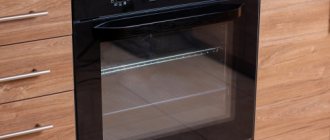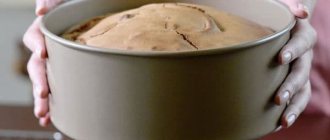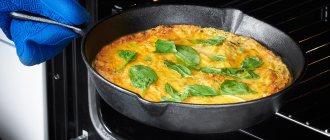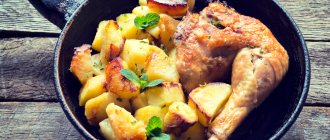One of the most common failures in making pies is unbaked dough. Let's look at why the cake is not baked inside and how to fix it.
7 reasons for a bad pie:
- There wasn't enough time for the pie. If the crust is light and soft, but the dough inside is raw, then the pie still needs to sit in the oven. Not following the baking time recommendations in the recipe is the easiest option.
- The oven temperature was not high enough. If the pie looks pale, the crust is light and more weathered than baked, you should suspect that the oven was not warmed up enough.
- The temperature at the start of baking was too high. If the crust is hard, dark, and there is raw dough underneath, then the pie baked too quickly. The crust hardened and began to burn, but the core did not have time to get ready.
- Oven heating was uneven. Part of the pie in this case looks quite appetizing, but the rest is clearly left unprepared. Most likely, not all elements have heated up to the required temperature.
- The pie was not baked because... stood too high or low in the oven. If the top or bottom part is not baked, then the location of the pie pan is chosen incorrectly.
- The pie is heavy and low, the crust is hard. The dough did not rise: perhaps there was an error in its preparation.
- Uncooked areas remained around the filling. If you wrap something cold in the dough, such as frozen berries, it will be very difficult to bake the pie evenly.
Carefully read the instructions about the baking time and temperature for this type of dough, make sure that you put all the specified ingredients in the right quantities.
Why isn't the inside of the pie baked in the oven?
Unfortunately, it’s not uncommon when you cut a product and the inside is raw. There are different reasons:
- Failure to comply with the proportions specified in the recipe. If you deviated from the recommendations and added more flour or sugar, thus violating the consistency, this incident could occur. It’s not just that a certain number of components were selected;
- Another reason could be an incorrectly set heating time or temperature. You cannot put baked goods in a very hot oven when it is already 220 degrees. The optimal option is 160 degrees. If the recipe specifies a higher temperature, it is better to place the pie at 160, then it will gradually heat up along with the oven. The average time is 30 minutes, it can be increased, it all depends on the size of the dish.
Always check for doneness by inserting a wooden object, toothpick or match into the pulp. If the dough sticks, the dish is not ready , you need to hold it some more.
What to do?
It is worth saying that sometimes preventing the mistakes described above does not help. And women clutch their heads, not knowing how to impress guests, family and friends with their cooking. Fortunately, all the secrets are freely available and are presented just below:
- Don't forget to sift the flour before adding it to the dough. It's a simple thing, but very useful. Airiness is guaranteed;
- optimality - in everything! Including the temperature of the water for breeding yeast in it. It should be exactly like that of a person bursting with health - thirty-six. Too cold a liquid will make you wait a long time until the dough deigns to “rise”, and a hot one will not only ruin the whole miracle of “rising”, but can even lead to spoilage of the product;
- Dishes - dry only! This is especially true for the one in which the whites will be beaten. One more note about this painstaking process: it is important to accurately separate the yolks from the whites. There are several ways to do this, including separating by hand, using a paper funnel, or using a knife or needles;
- intuition is intuition, and clear instructions are drawn up for a reason. If the recipe specifies an exact baking time, time it! Fortunately, stopwatches are not uncommon now. Otherwise, don’t ask why the cake sag after baking, but “enjoy” what has fallen. By the way, this also applies to temperature regulation: sometimes it is necessary during the baking process. Well, setting the required value at the beginning of cooking is a sacred task for servants of the culinary art;
- follow the sequence of actions. Remember how in Harry Potter? In order for the potion to turn out correctly, it is necessary not only to add all the ingredients, but in the correct order, and also to stir the exact number of times in a strictly indicated direction. Likewise, baking has its own secrets. For example, that soda cannot be extinguished separately from the dough, and especially not in advance. This is done directly together with the other ingredients, and is explained by the fact that the fluffiness should be achieved through gases, and if the product is not quenched in the dough, some of them (most of them) will simply evaporate.
What to do if the cake is not baked inside?
Little culinary tricks for real housewives.
Quite often, the reason for an unbaked pie is the wrong temperature in the oven and the time when you put the pie there. Many people start baking the cake immediately at a temperature higher than 220 degrees. This is exactly what you don’t need to do. It is better to put it in the oven when the temperature is lower, 160 degrees. And then, at this temperature, bake the pie for about 30 minutes. Of course, 30 minutes can also vary in any direction. Everything here will depend on the volume of your baking. After this time, you need to check the dough inside for readiness.
This is done with a match, a toothpick or a wooden skewer. Many people do this procedure and know that the dough should not stick to these wooden objects if it is ready. Once you are sure that it is definitely ready inside, then you can increase the temperature. This will allow you to brown your dish nicely and appetizingly.
Mathematical proportionality - time to brainstorm
Reason number five: the proportions of the test components were violated. If too much flour or, on the contrary, liquid was initially added to the dough, it will not rise as the hostess wants. Beginners are advised to make the mixture exclusively according to the recipe, while more advanced ones should act almost intuitively, on a whim, selecting the amount of certain elements of the composition. In any case, this reason is a very clear example of how baked goods can be spoiled long before they are put into the oven.
Do you have new household appliances in your home?
A common cause is a new stove or other baking-capable appliance. You haven’t gotten used to it yet and don’t know her “character.” Oddly enough, you will have to get used to the device; sometimes they cook differently and you need to know their whims.
To do this, experiment. Place the pie at the very bottom first and see what happens, then up. On the lower level, the dish is baked better on the outside, and it cooks better on the upper level. You may have to rearrange it several times during one cooking.
And again, it all depends on the capabilities of the technology. For the first time, you can buy a special mold with a hole in the middle. It will help bring the dish to the desired condition.
Why wasn't the bottom of the pie baked?
This situation is not uncommon even among experienced housewives. Most often this happens if the lower heating element of the electric oven is not operating at full capacity. There is still a way out: you need to place the baking sheet on the lowest level of the oven. When the bottom is baked, the baking sheet should be placed several levels higher so that the middle “reaches” and the surface of the pie acquires a pleasant golden crust.
Another reason is the oversaturation of the dough with sugar. The sweet substance settles, heating promotes the rapid formation of the bottom crust, which prevents the pie from baking from below.
Individual approach to the test
Each type has its own mode. Don’t believe it if some cookbook says that any baked goods are cooked at 180 – 200 degrees. This is not true; individual recommendations on time and temperature . Otherwise, the pie will turn out underbaked or burnt.
To prevent this from happening, learn the rules for working with different types of dough:
- In order to prepare the sand mass well, the ingredients must be used chilled. The temperature in the oven should be in the range from 220 to 240 degrees;
- Biscuit dough is the most capricious. To prevent it from turning out raw, it must be made fluffy. To do this, separate the whites from the yolks and well . Then immediately place the mold in the oven, heated to 200˚. But after 10 minutes the temperature is reduced to 170˚. And do not open the oven during cooking, otherwise the mass will sink and there will be a damp layer inside;
- to mix the yeast , otherwise the mass will turn out heavy and dense, which means it will not be cooked completely. Then you need to put it in a warm place so that it rises and becomes fluffy. Set the stove setting to 200˚.
The difference in preparation, as you can see, is significant, so be sure to focus on the type of dough to get delicious baked goods.
Compound
If the cottage cheese casserole falls every now and then and there is no sweetness with it, you can experiment with the composition. There are many means to add fluffiness to culinary products: from soda slaked with vinegar/citric acid, etc., which was used by our grandmothers and great-grandmothers, to baking powder, helpfully supplied to the market by many manufacturers and sold at every kiosk. Essentially, of course, it will most likely contain the same soda and the same citric acid. But if the housewife is accustomed to trusting purchased products, why not? After all, they also work. In addition, there is definitely less hassle with them. There is no need to think about at what point to add and how to “extinguish” the baking powder. He will do everything himself.
Both baking soda and baking powder are an option for the most persistent, but it is very important to remember that it is important not to overdo it with these products. After all, in the end, the baked goods will not only fall, but will not rise, and will also smell of soda and ammonia (this is sometimes found in baking powder).
How to finish baking a pie if it is not baked?
What to do in such a situation? It’s a shame to throw it away; sometimes there’s not enough time to make a new one. We'll have to revive this one.
There are several ways
- First of all, you need to turn down the heat;
- Now place a frying pan with water on the bottom of the oven. Grease the surface of the pie with butter and milk and give it more time to steam;
- Or cover it with foil and finish baking at a lower temperature;
- If you are baking in a miracle oven and the bottom turns out to be raw, move the oven to the stove and finish frying the yummy food;
- If you have a capricious technique, the best option would be to buy a mold with a hole, which we wrote about above. Then everything will definitely work out and you won’t have to start all over again.
The most important thing is to follow the recipe technology . If the technique is to blame, you will soon get used to it, but you will have to experiment a little.
Patience
Firstly, you should remember this rule once and for all: do not remove the baked goods immediately! Yes, this reason has already been indicated, but even experienced housewives “get caught” so often that it’s not a sin to remind you again. Temperature changes are a serious matter. When asked why the charlotte settles after baking, a cupcake or the same casserole - most likely, this was the problem. Sometimes it’s not even a matter of the baked goods being taken out—the dough most likely fell out the moment the oven door was opened. So you can’t even peek or even “look”!
If your pie is not baked. Why and what to do?
“What is this pie missing?” - you think, “what’s wrong, did I do it again?” Questions that you sometimes cannot answer for yourself. But really, what’s wrong?
- Quite often the reason for such an unbaked pie is the wrong temperature in the oven and the wrong time when you put the pie there. Many people start baking the cake immediately at a high temperature, 220 degrees. This is exactly what you don’t need to do. It is better to put it when the temperature there is lower, 160 degrees. And then, at this temperature, bake the pie for about 30 minutes. Of course, 30 minutes can also vary in any direction. Everything here will depend on the volume of your baking. After this time, you need to check inside for readiness. This is done with a match, a toothpick or a wooden skewer. I think many people do this procedure and know that the dough should not stick to these wooden objects if it is ready. Once you are sure that it is definitely ready inside, then you need to increase the temperature. This will allow you to brown your dish appetizingly.
- If you did allow this to happen just this time, then it is also quite possible to save the pie, even though it is already too brown on the outside and a little damp on the inside. You just need to reduce the temperature in your oven, and it would be better to cover the pie itself with a suitable material that can withstand this temperature. This can be foil, or you can cover it with parchment paper instead.
- Sometimes the pie doesn’t bake because you didn’t add something, or you overloaded it, that is, you didn’t follow the recipe.
- Also, the pie can burn and remain damp inside due to the oven. That's just how she works. Therefore, you need to know the “character” and operating features of your oven or strive to quickly find out. So you don’t have to place the cake high right away, but place it at the very bottom of your oven to begin with. There the dough will rise better and it will be baked from below. After this, you can raise the cake higher, to where it should be during the baking process. Already on the top shelf of the oven it will be baked on top and will also be browned.
- In addition, when the inside of the pie is still damp, you can again turn down the heat a little, put some frying pan with water on a lower shelf, and then finish baking the pie, while greasing the top of it as well. You will have 10 or 15 minutes to finish baking the pie. and in humid air it will bake better.
- If your oven does not want to bake the cake from the inside, then it is better to buy a special one that has a hole in the middle. This way the middle will always bake without problems.
What to do when you cook baked goods in a slow cooker and it turns out raw?
Today many people use this device, it is really convenient. I threw in the ingredients, chose a mode and went about my business. But often the dough remains unbaked. Can this be fixed in a slow cooker?
Here's what experienced housewives advise:
- You need to put the dish back, switch to the “multi-cook” mode, lower the temperature and add 20 minutes;
- Some chefs advise turning the baked goods 20 minutes before the end of the program;
- If you are making cupcakes, be sure to add baking powder. It will make it airy and allow it to cook properly.
And there is one more secret. If you did not take the recipe from the special book that came with the multicooker, it may not fit your model. Different models have different power, and this increases or decreases the cooking time. The greater the power of the device, the fewer minutes you need to set. Perhaps the recipe was taken from the Internet and the model is not indicated. Then you'll have to experiment.
It's a shame when your favorite buns and pies turn out raw. So much effort and time is spent on making them. But there is a way out, and if your pie is not baked, you should not get upset and throw away the workpiece. You need to finish it using the tips above.
The nuances of using a multicooker for baking
0
Source:
This kitchen assistant has many fans, since the multicooker allows you to save time on cooking. But novice housewives often complain that they prepared the dough strictly according to the recipe, but the pie still turns out beautiful, but unbaked. In this case, you can try to return the container to its place, start the “multi-cook” mode and add 15-20 minutes of time. Some people recommend turning the cake when there is less than half an hour left in the program. It is important to take into account the recommended temperature conditions, since baked goods take longer to cook in a multi-pan than in an oven. Also, the recipe used may not correspond to the model of kitchen appliance, since different models have different power, which also affects the cooking time.
The subtleties of baking a pie in a slow cooker
- Check if the recipe is suitable for this model. The power and functions of different multicookers are not the same, so the cooking time indicated for one model will not work on another.
- In some cases, the “Multi-cook” mode will help, in which you manually set the time - 15-20 minutes.
- It will take more time to cook in a slow cooker: 50-60 minutes are recommended for baking. However, you cannot open it earlier.
- The “Keep Warm” mode allows the cake to finish baking in the multicooker.
Do not put more into the slow cooker than it can bake. A simple way to determine the quantity: the height of the pie when raw should not be more than 3 fingers.
Pies require the cook to have certain skills and familiarity with the technique in which they will be baked. But even if you fail, you shouldn’t let go and give up the idea of enjoying baked goods.
See also: Recipe for Lenten pancakes.
Causes
Not all housewives are able to determine the cause of failure when baking bread or culinary products. Many factors can be to blame: failure to comply with the proportions of the required ingredients, the use of new household appliances, cooking time or temperature conditions. Let's look at some of them.
Types of test
The large variety of dough allows you to prepare hundreds of options for various baked goods. It is important to remember that they all require maintaining a certain temperature and knowledge of the nuances of preparation. For example:
- for shortcrust pastry,
the ingredients should be mixed chilled, the mass should not be kneaded for too long, and it should be baked when the oven is heated to 240°; - yeast
must go through the fermentation stage and, as a result, increase its volume by at least 2 times. It should be baked at 180° - 200°; - Puff pastry
contains a large amount of fat, so it is recommended to bake it at 250° to form crispy, tender plates. Otherwise the layers will not rise; - the pastry
will not bake due to excess sugar; - the protein mass
must be baked with the oven heated to no more than 100°; - sponge cake
is even more demanding in terms of baking conditions: place the pan with the semi-finished product in the oven at 200°, and after 10 minutes reduce the temperature to 170°. Important: the oven door cannot be opened until the cooking process is completed. In this case, the cake is not baked and remains raw inside.
What to do if a pie burns in the oven
It's all in the oven: taming the gas oven
Most of our housewives bake using an ordinary gas oven. The main feature (disadvantage) of gas ovens is the heating that comes only from below. For this reason, the temperature of a gas oven is the most difficult to regulate. And even convection won’t help much here. Therefore, if your baked goods are poorly baked (raw inside, but the bottom is already black), then it’s all about improper heat distribution.
Fortunately, there are ways that can help you in this situation. The most productive of them:
- Purchase a special stone for baking in a gas oven. Baking stone has a special porous structure and high heat capacity, thanks to which it acts as a kind of heat transfer buffer. If you place your baking stone in a gas oven, all your baked goods will cook evenly at the same temperature. Such stones are made from fireclay clay. You can buy them in a store or from a familiar stove maker. Many housewives use ordinary red brick instead of stone. This method also works, but it is better to use a baking stone. We would like to draw your attention to the fact that under no circumstances should you use asbestos! It is harmful to health!
- If you are baking something in the oven that requires quick cooking, then it is better to use a bowl with water in this case. Under the baking tray with baked goods you need to place a large and deep container with water. Water also helps a gas oven heat evenly, but is best suited for quick-cooking baked goods.
If for some reason you cannot use a baking stone, then you can get by with ordinary table salt. You will need one ordinary pack of salt. Place a baking sheet at the very bottom of the oven with salt evenly distributed. Salt perfectly absorbs all the excess heat, thereby allowing any baked goods to bake evenly. Salt can be stored in a gas oven for years without spoiling at all. Therefore, if your pie, fish or meat often burns, you can always avoid this in this original way. As they say, cheap and practical.
Cold and hot
There are two ways to prepare a sponge cake. More precisely, the dough is for him. Depending on which one the hostess chooses, she will receive one or another result.
It cannot be said that one is guaranteed to be better and the other worse. But cold is suitable for ethereal-light rolls, the crumbliness of which is unbecoming.
A hot one gives a dense result, and after it you don’t have to wonder why the sponge cake settles after baking - after all, this usually doesn’t happen.
With this method, the dough is prepared in a water bath. It should be noted that many cooks prefer the cold method - as it is lighter, simpler and more understandable. But if the main thing is the result, it would be good not to be lazy and work hard to get the perfect sponge cake that will not fall.
Why the pie is not baked inside: the secrets of successful baking (5 photos)
7 reasons why the pie is not baked
Among the main and most common reasons why baked goods turn out raw inside are the following:
What to do if a pie burns in the oven
Probably, every housewife is familiar with the situation when such a desired pastry (pie, cupcake or pies) burns in the oven for some unknown reason. And this always happens when you really want to surprise your loved ones with something delicious.
Today in the culinary section, Notagram will talk about how you can beat the oven so that you can always enjoy the baking process, and your baked goods never upset you or burn in the oven.
In order to understand the true reasons why your favorite pies or pie begin to burn, you need to dwell on the following technological points. In most cases, they are the underlying cause of spoiled baked goods and bad mood.
Will diligence and labor grind everything down?
Reason number four: whipping too long with a mixer. Housewives who do not have this important attribute in the kitchen envy those who own it with not white envy. After all, you have to beat it manually: with a whisk, or even with a fork. But perhaps they were luckier in some ways? After all, a mixer can also be the reason why a sponge cake settles after baking? Or not a sponge cake, but a birthday cake, which everyone was so hoping for, and for which it is so offensive. The secret is that everything needs to be done in moderation: beat enough so that the dough is airy, but not so long that it “falls” from shock.











